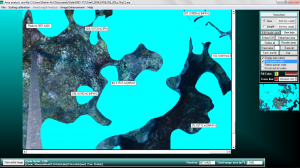
Alvi runs planar area analysis using CPCeV4.1, which outlines the live coral and calculates the percent live coral cover.
Fatima Alvi, a senior majoring in Ecology & Evolutionary Biology, recently took EBIO 372, Coral Reef Ecosystems, a course that explores the complex ecology of coral reefs. “We cover both biotic and abiotic components of coral reefs, the factors that contribute to reef construction and decline over time, and various ways in which reef organisms interact with their environment,” said Alvi. But how does one begin to explore these complex reefs? Technology may be the answer.
For her project to analyze sections of coral reefs from photographs taken at the Flower Garden Banks National Marine Sanctuary, Alvi used the program CPCeV4.1 (Coral Point Count with Excel extensions). She described how the class “assessed percent live coral cover in the images using both point overlay analysis and planar area analysis, which involve classifying the benthos at 100 randomly assigned points and outlining the areas of live coral cover, respectively.” Sound complicated? While she hadn’t expected using this technology in the course, coral reef ecologists typically use this software in a similar capacity.
“This course not only involves classroom learning, but also teaches methods that coral reef ecologists use when studying coral reefs. To that end, it was instructive to have exposure to the actual software used in the field, especially for those interested in further exploring research in coral reefs.”
While Alvi says she doesn’t plan on working with coral reefs in the future, she believes that this class has given her a much deeper appreciation for how unique and complex coral reefs are and emphasized the importance of conserving these ecosystems as they face rapid decline in the near future.

